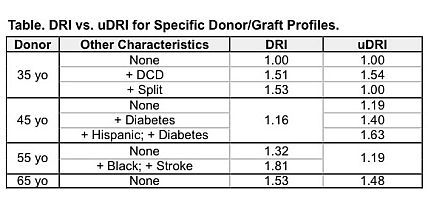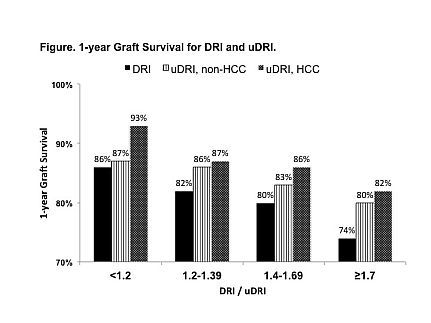Evolving Face of Liver Donors: Updating the Donor Risk Index, The
Medicine, UCSF, San Francisco, CA
Surgery, UCSF, San Francisco, CA
Biostatistics, UCSF, San Francisco, CA
Meeting: 2013 American Transplant Congress
Abstract number: 188
Background Derived from 1998-2002 liver transplant (LT) data, the DRI has served as a common language to analyze LT utilization practices and outcomes. We examined changes in donors and the DRI over the last decade.
Methods All deceased donors for US adult, non-Status 1 LTs from 1998-2002 (Era 1) vs 2007-10 (Era 2) were studied. Cox models assessed the independent effect of donor factors on the rate of graft loss, adjusting for recipient characteristics and UNOS region. An updated DRI (uDRI) was created with significant donor factors for Era 2.
Results From Era 1⇒Era 2, LT donors increased significantly in age (39 vs. 43y), Black (11 vs 17%) / Hispanic race (10 vs 13%), weight (74 vs. 78kg), hypertension (20 vs. 29%), diabetes (6 vs 12%), and donation after cardiac death (DCD) (1 vs 5%) [p<0.001]. Of the original DRI factors, age, height, DCD, and cold ischemia time remained associated with adjusted graft loss while Black race, cause of death, and split liver did not. New risk factors were Hispanic race (HR 1.16; 95%CI 1.07-1.27) and diabetes (HR 1.18; 95%CI 1.08-1.27)[p≤0.001]. The uDRI, vs the DRI, changed markedly for some common donor profiles (Table). Graft survival decreased by uDRI strata (Fig). The similarity of split liver donors between eras suggests that technical advances or optimized recipient selection improved outcomes.
Conclusion: Over the past decade, LT donors have significantly aged, bearing an increasing burden of medical comorbidities. The emergence of 2 new risk factors (Hispanic race, DM) and disappearance of 3 old risk factors (Black race, cause of death, split) led to dramatic changes in the risk of common donor profiles. While technical advances and/or recipient selection completely mitigated the negative impact of split grafts, DCD grafts continue to pose comparably high risk of graft loss.


To cite this abstract in AMA style:
Lai J, Vittinghoff E, Feng S. Evolving Face of Liver Donors: Updating the Donor Risk Index, The [abstract]. Am J Transplant. 2013; 13 (suppl 5). https://atcmeetingabstracts.com/abstract/evolving-face-of-liver-donors-updating-the-donor-risk-index-the/. Accessed November 5, 2025.« Back to 2013 American Transplant Congress
